April 30, 2017
Gigabit in Baton Rouge
My ISP wouldn't give me a list of where they were providing gigabit internet. So I made my own.
A few days ago, I asked my ISP what I thought was a simple question:
@CoxHelp I’m trying to find out where in my city Cox is offering Gigablast internet. Who can I reach out to that would be able to help me?
— Dylan Staley (@dstaley) April 25, 2017
The response I received pointed me towards a page on Cox's website that allows you to enter an address to see if it had access to Gigablast, Cox's gigabit internet service. Since I was more curious about the areas in which gigabit was offered (as opposed to a single address), I tried several more times to get in touch with someone at Cox who might be able to provide a list of neighborhoods.

According to the five separate Cox representatives I spoke with, the only way to figure out where Cox is offering gigabit internet is to put addresses into their website, one by one.
So, I did. I checked whether Cox was offering gigabit internet for all 168,000 addresses listed in the city's Open Data portal.
After checking every address in the parish, I was incredibly surprised by how difficult it apparently was for Cox to give me a list of neighborhoods considering that such a list would have only been two neighborhoods long. In the almost two years since Cox announced the availability of their gigabit service at a ceremony in a neighborhood where the cheapest home starts at $288,000, they've managed to roll the service out to a single additional neighborhood. The cheapest home in that neighborhood starts at $390,000.
In November of last year, AT&T announced that their fiber network was available in Baton Rouge, so I used the same method to check where they were offering service. Whereas only 200 addresses have access to Cox's gigabit service, almost 10,000 have access to AT&T's. That means that while Cox's gigabit network is available to only 0.12% of addresses in the parish, AT&T's gigabit service is available to 6%, fifty times more. What's even more surprising is that AT&T's network isn't limited to recently built homes. I was pleasantly surprised to find several homes built in the 70s that have access to gigabit from AT&T.
However, what I didn't find were addresses in North Baton Rouge, despite the fact that the area was explicitly called out as having fiber in AT&T's November press release. In fact, if you map out the areas where AT&T is offering gigabit and compare it to median household income, a (sadly unsurprising) trend emerges.
A few weeks ago, Ars Technica published an article with the headline "AT&T allegedly "discriminated" against poor people in broadband upgrades", which highlighted a report that demonstrated there was virtually no overlap in areas that had fiber-to-the-home and areas that had a poverty rate of 35% or more. It's unsurprising that lower-income areas in Baton Rouge are being left out as well.